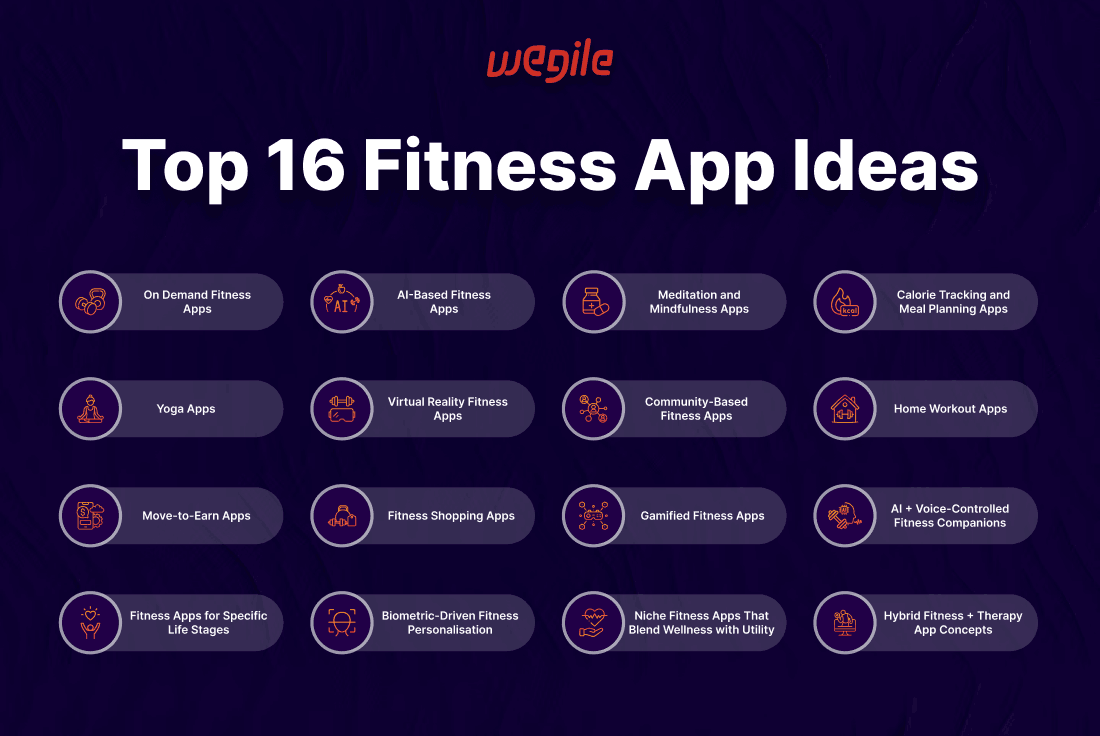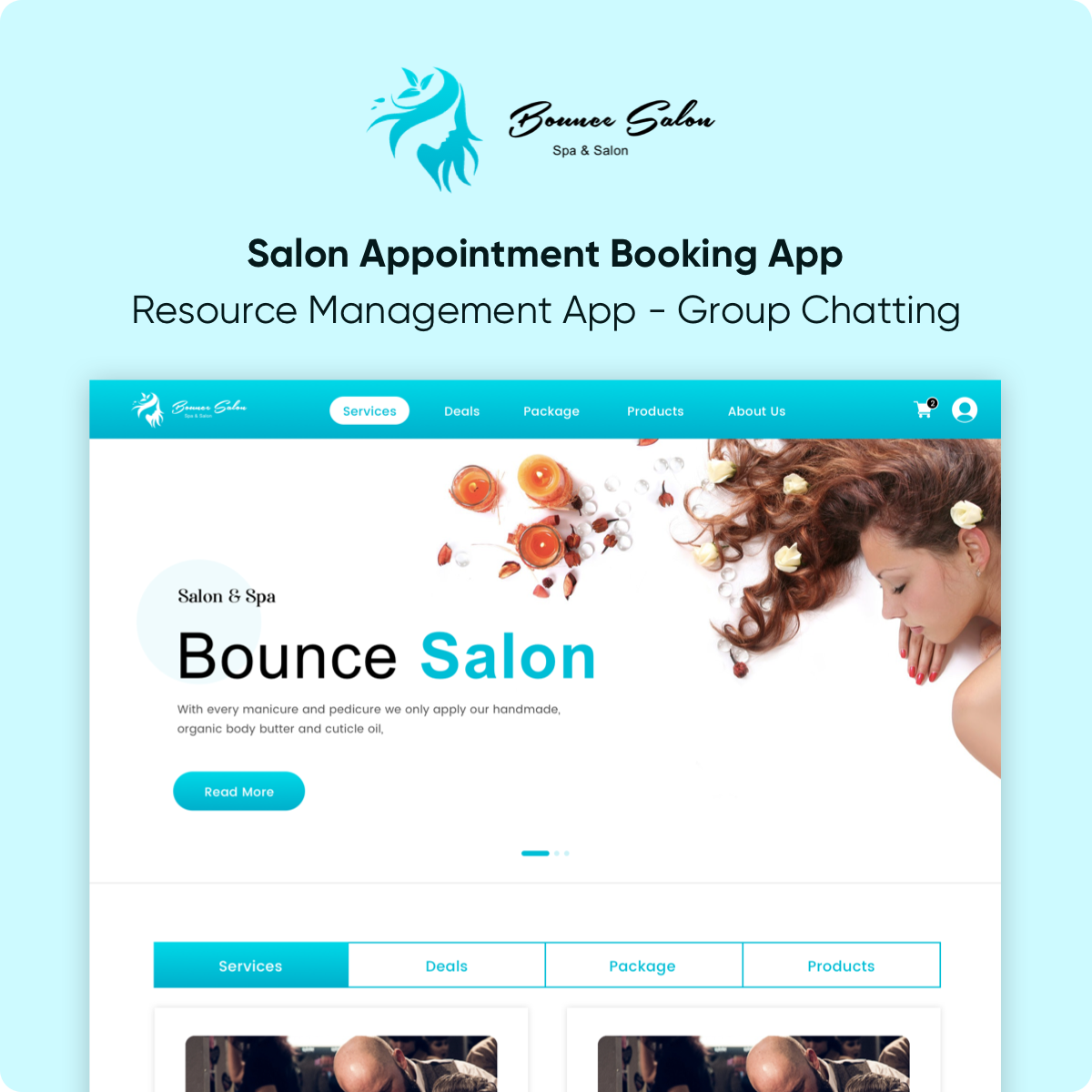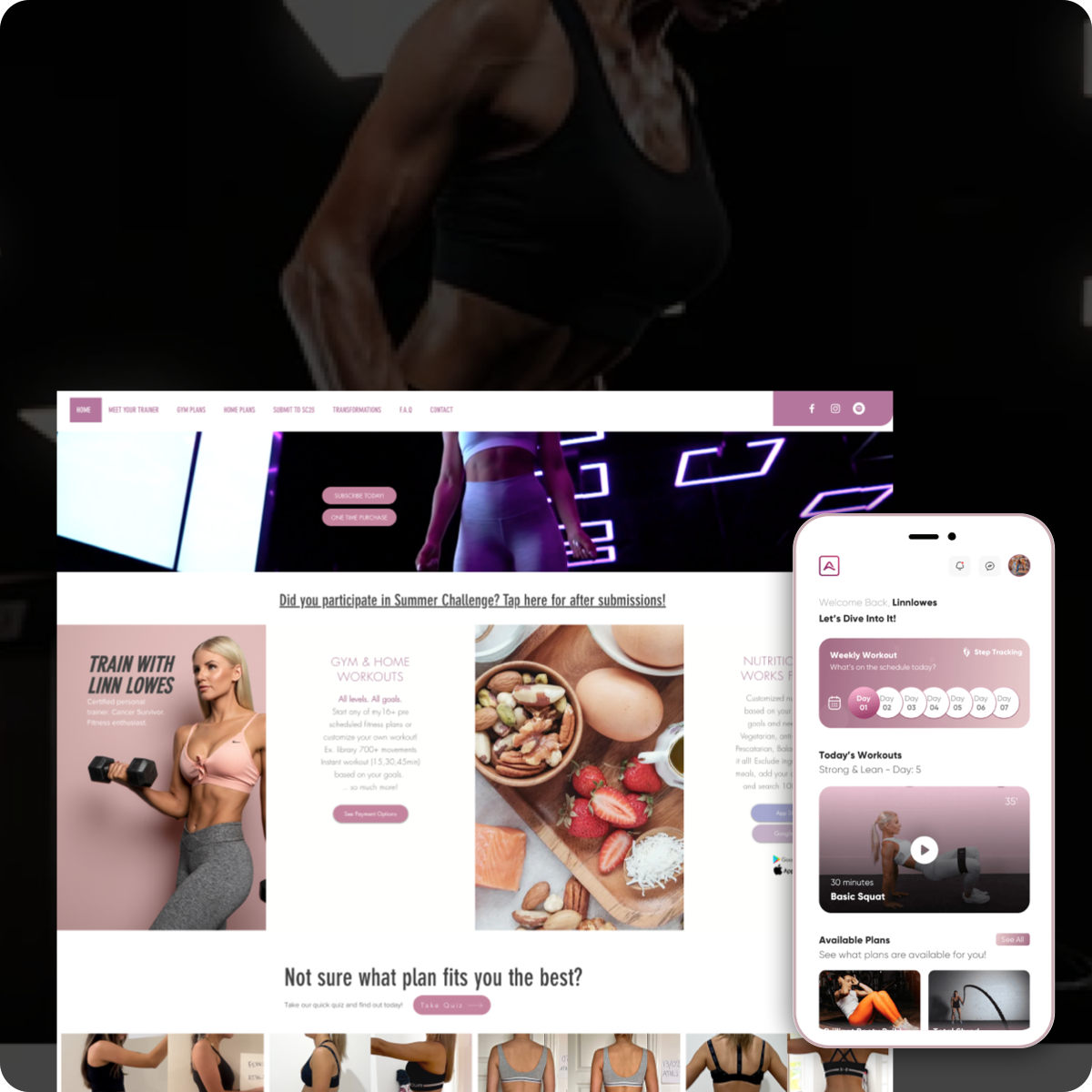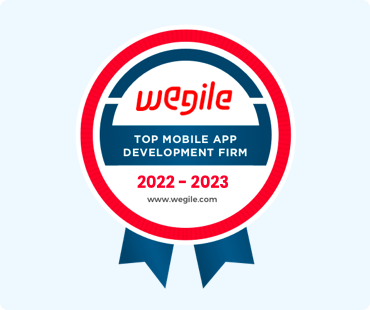The fitness industry has evolved significantly, and with the rise of technology, it's opening new avenues for innovative fitness apps that embrace the latest trends. With health and wellness at the forefront of priorities in our digital age, cutting-edge fitness apps are more in demand than ever before. As individuals seek convenient and personalized solutions to meet their fitness goals, the role of fitness apps becomes increasingly vital. Understanding fitness app ideas is not just about exploring options; it's about recognizing the diverse possibilities available to meet individual health and wellness goals. Each idea represents a unique approach to fitness, tailored to different preferences and needs. In light of this knowledge, individuals are empowered to make informed fitness app choices that match their specific fitness goals. This blog delves into various fitness app ideas, offering a comprehensive guide to inspire and guide you on your wellness journey.
Before exploring fitness app ideas, many people may have the following question: "Is creating a fitness app worth it?" The fitness app industry, marked by its dynamic and ever-evolving nature, unfolds a terrain filled with opportunities and innovations. According to Statista's reports, revenue in the Fitness Apps market is expected to hit US$5 billion by 2023, indicating a substantial annual growth rate (CAGR 2023-2028) of 14.96%. This trajectory sets the stage for a projected market volume of US$10.04 billion by 2028. These numbers underline the industry's upward climb, indicating a positive outlook and potential for sustained growth and profitability. As we delve into the market overview, these statistics serve as a robust foundation for comprehending the present and future dynamics of the fitness app landscape.
Must Read: Fitness App Development Cost: Essential Insights
In today's fast-paced world, on-demand fitness apps are coming into their own as the solution to time constraints. These apps allow users to access workouts at their chosen time and location, presenting an array of options from live sessions with trainers to pre-recorded routines. The emphasis here is on making fitness convenient and tailored to individual schedules, fostering seamless health integration into daily life. Peloton offers on-demand fitness classes, including cycling, running, strength, and yoga. Users can access a vast library of workouts anytime, bringing the gym experience to the comfort of their homes.
The integration of Artificial Intelligence (AI) into fitness apps signifies a paradigm shift in how individuals approach their well-being. AI-powered fitness apps analyze user data to craft personalized workout plans, track progress, and dynamically adapt routines based on individual goals. This personalization ensures a unique fitness journey for each user, enhancing the overall experience and setting a new standard for individualized health and fitness solutions. Freeletics leverages AI to create personalized workout plans based on individual fitness levels and goals. The app continuously adapts and refines the training regimen, providing users with dynamic and effective workouts.
Must Read: Best Practices For Fitness App Development In 2024Acknowledging the integral role mental well-being plays in overall health, meditation, and mindfulness apps guide users through practices that promote stress relief, improved focus, and better sleep. These apps provide more than just a fitness routine; they contribute to a balanced and integrated approach to holistic wellness, creating a sanctuary for mental rejuvenation amid life's demands. Headspace guides users through mindfulness practices, meditation sessions, and sleep exercises. It focuses on mental well-being, stress reduction, and enhancing overall mindfulness. Read our insightful guide on how to create a meditation app to dive deeper into the art of crafting a digital sanctuary for mental health and mindfulness.
Nutrition is a cornerstone of fitness, and apps focused on calorie tracking and meal planning empower users to make informed dietary choices. By facilitating the monitoring of nutritional intake, these apps play a vital role in helping users stay aligned with their health and fitness goals. They go beyond workouts to address a fundamental aspect of well-being, ensuring a comprehensive approach to health management. MyFitnessPal allows users to track their food intake, log exercises, and set personalized fitness goals. It provides insights into nutritional information and offers meal planning features for a comprehensive approach to health.
Yoga, with its holistic approach to wellness, has seamlessly transitioned into the digital realm through yoga apps. These apps cater to practitioners of all levels, offering guided sessions, pose tutorials, and personalized routines. The aim is to enhance flexibility, build strength, and foster inner balance, making yoga accessible to a broader audience. With these apps, yoga becomes not just a practice but a transformative journey toward physical and mental well-being. Daily Yoga provides a diverse range of yoga classes suitable for all levels. Users can follow guided sessions, track their progress, and enjoy a variety of yoga routines to improve flexibility, strength, and mental well-being.
Embracing cutting-edge technology, virtual reality (VR) fitness apps redefine the workout experience. These apps transport users to immersive environments, turning exercise into an engaging adventure. Whether cycling through virtual landscapes or participating in interactive fitness challenges, VR fitness apps add an element of excitement to workouts, making them more enjoyable and motivating. FitXR combines VR technology with fitness routines, offering users immersive workouts set in stunning virtual environments. It turns exercise into a captivating experience, enhancing motivation through virtual reality.
The power of community can significantly impact one's fitness journey, and community-based fitness apps tap into this potential. These platforms connect users with similar health goals, fostering a supportive environment for shared challenges, achievements, and motivation. The sense of accountability and camaraderie within these communities enhances the overall fitness experience, turning individual pursuits into collaborative endeavors. Fitbit Community connects users with similar fitness goals, allowing them to participate in challenges, share achievements, and seek motivation. The app fosters a sense of community to enhance the overall fitness journey.
Recognizing the increasing preference for home-based workouts, home workout apps offer curated routines that require minimal or no equipment. Whether it's high-intensity interval training (HIIT), bodyweight exercises, or yoga, these apps cater to users looking to stay fit within the comfort of their homes. Home workout apps democratize fitness, making it accessible to anyone, regardless of their location or gym access. 7 Minute Workout app provides quick, effective home workouts that require only seven minutes. It offers a range of exercises targeting different muscle groups, making it convenient for users with busy schedules.
Innovating on the concept of fitness incentives, move-to-earn apps introduce a gamified approach to staying active. Users earn rewards or incentives by achieving certain fitness milestones, completing challenges, or maintaining consistent activity levels. This gamification not only motivates users to stay physically active but also adds an element of fun and competition to their fitness routines. Sweatcoin rewards users with virtual currency (Sweatcoins) for every step they take. These coins can be exchanged for various products, creating an incentive for users to stay active and earn rewards.
Combining retail therapy with fitness goals, fitness shopping apps curate products that enhance and complement users' health journeys. From workout gear and nutritional supplements to fitness gadgets, these apps provide a convenient platform for users to discover and purchase items that align with their fitness aspirations. It's a holistic approach to both health and lifestyle, merging wellness with retail convenience. Nike Training Club not only offers workout routines but also features a shopping section where users can explore and purchas Nike fitness apparel and accessories, seamlessly integrating fitness with lifestyle.
Gamification takes center stage in fitness apps, turning workouts into engaging challenges. Users embark on quests, earn points, and unlock achievements as they progress in their fitness journey. This approach injects an element of playfulness into workouts, making them more enjoyable and compelling. Gamified fitness apps transform routine exercises into exciting adventures, keeping users motivated and committed. Zombies, Run! gamifies running by immersing users in a post-apocalyptic story where they need to complete missions while avoiding virtual zombies. The app turns jogging into an interactive game, adding excitement to outdoor workouts.
Must Read: Benefits of Fitness App DevelopmentHere are a few more fitness app ideas, each explained with a bit more depth to help you think through their potential impact and usefulness.
Voice technology is entering fitness with surprising impact. With AI-based fitness voice assistants already guiding smart homes, it makes perfect sense for them to guide fitness routines too. These apps deliver an interactive experience without needing to touch your phone during workouts.
Here are some standout AI voice-controlled fitness app ideas you can explore:
The app listens to your commands and watches your movement through your phone camera or wearable sensor. It gives real-time feedback if your form is off or if you're missing reps. It mimics having a personal trainer with constant attention on your posture.
Instead of generic voiceovers, these apps offer adaptive coaching. They switch tone, speed, and intensity depending on your energy levels and exercise history. It keeps workouts motivating without the repetition.
Instead of relying on user prompts, voice-enabled fitness apps initiate the conversation. Based on your behavior, it may say, "You haven't done core work this week. Want to squeeze in five minutes of planks?"
AI tracks breathing and gives vocal cues when it senses you’re off pace. For cardio or yoga, this creates more awareness and control without needing to stop and check the screen.
You no longer have to stop midway to switch exercises. Just say, “Next workout,” and it transitions instantly. This makes high-intensity or flow workouts smoother and more engaging.
Not all fitness journeys look the same. Different age groups and life stages demand custom tools. Developing apps tailored to specific demographics can help address underserved niches and drive long-term loyalty.
Below are fitness app ideas that focus on user life stage and age specificity:
These apps cater to women recovering from childbirth. They offer slow-paced movement routines approved by medical experts. They also include mental health support and pelvic floor strengthening.
Seniors need different metrics. These apps prioritize fall prevention, joint mobility, and heart-safe exercises. AI adjusts intensity levels and flags anomalies that could indicate health risks.
Teens are digitally native but often sedentary. Gamified fitness apps for teens use streaks, peer challenges, and school-integrated routines to build lifelong movement habits.
These niche fitness apps track recovery milestones and suggest low-impact exercises prescribed by physiotherapists. They’re especially useful for knee, hip, or spinal surgeries.
These fitness apps adapt routines based on energy levels, joint inflammation, and hormonal fluctuations. The goal is consistency, not intensity, so users feel supported, not punished.
Fitness apps that connect with wearables are just scratching the surface. As biometric tech evolves, we can expect apps to deliver even more granular, actionable insights.
Here are some fitness app directions based on biometric feedback and analytics:
The app reads your HRV trends and tells you whether to push or rest that day. This balances performance with recovery and prevents overtraining.
If your wearable data shows poor sleep, the app adjusts your workout to avoid injury and optimize fat burn. It can delay heavy lifting to the next day when you're better rested.
Using heart rate, skin temperature, and voice tone, the app senses your stress levels. Then it recommends stretching, walking, or breathing routines to regulate your nervous system.
Linking with blood tests or food diaries, these apps suggest training intensity based on your nutritional health. Low iron or protein? You’ll get lighter routines until you recover.
For mountaineers or runners training at elevation, apps can alert users to risk zones and offer warm-up cooldowns tailored to oxygen intake patterns.
Not every fitness app needs to revolve around workouts. Some ideas blend health with lifestyle and address secondary goals like productivity, routine-building, or wellness tracking.
Following are niche app types that bring together wellness, utility, and lifestyle:
These apps integrate step goals, hydration reminders, and focus sessions with your calendar. They help balance meetings, meals, and movement in one dashboard.
By syncing with your wearable, this app reminds you to hydrate. It considers weather, activity, and body weight to suggest how much water and sodium you need.
Unlike general fitness apps, these put sleep at the core. They limit late-night notifications, auto-schedule early workouts based on circadian rhythm, and link sleep quality to performance gains.
These are designed for users managing depression or anxiety. Every workout is paired with a mood rating. AI then correlates which types of exercise improve the user's emotional baseline.
This idea helps users stay fit on the move. Whether they’re in hotels or coworking spaces, it recommends bodyweight routines or local gyms with day passes.
As mental health and physical health continue to converge, fitness apps are now exploring ways to support both simultaneously.
Here are new fitness app concepts that merge therapy and movement for a holistic experience:
Cognitive Behavioral Therapy is enhanced with physical routines. After every journaling session, users are prompted to stretch or walk, reinforcing mental reflection through motion.
Post-workout reflections allow users to check in emotionally. Apps can ask short prompts like, “What did you feel during this session?” over time, patterns emerge, guiding custom coaching.
Using voice tone analysis or facial expression tracking, the app detects mood and suggests a workout accordingly. Frustrated? Try kickboxing. Anxious? Start with yoga.
Instead of ending a workout with silence or music, apps guide users through short meditations while they stretch. This seals the mental benefits of physical activity.
For partners training together, these apps offer shared goals, conflict resolution tips, and accountability features. They encourage connection through joint physical growth.
| App Ideas | Features | Benefits | Example |
|---|---|---|---|
| On-Demand Fitness Apps | Flexibility in workout timing, live sessions with trainers, vast library of pre-recorded routines | Convenient access to workouts at chosen time and location, gym experience at home | Peloton, Aaptiv, Daily Burn |
| AI-Based Fitness Apps | Personalized workout plans, dynamic adaptation based on user goals | Tailored fitness journey, effective and dynamic workouts | Freeletics, Sworkit |
| Meditation and Mindfulness Apps | Guided sessions for stress relief, improved focus, and better sleep | Holistic wellness, mental rejuvenation amid life's demands | Headspace, Calm, Insight Timer |
| Calorie Tracking and Meal Planning | Nutritional intake monitoring, meal planning features | Informed dietary choices, comprehensive approach to health | MyFitnessPal, Lose It!, Yazio |
| Yoga Apps | Guided sessions, pose tutorials, personalized routines | Enhanced flexibility, strength, and mental well-being through yoga practice | Daily Yoga, Asana Rebel, Glo Yoga |
| Virtual Reality Fitness Apps | Immersive workouts in virtual environments | Engaging and enjoyable exercise experience, enhanced motivation through virtual reality | FitXR, Beat Saber, VRWorkout |
| Community-Based Fitness Apps | Connects users with similar health goals, supportive environment | Sense of accountability, shared challenges and achievements, motivation through community | Fitbit Community, Strava |
| Home Workout Apps | Curated routines with minimal or no equipment | Accessibility to fitness routines at home, democratization of fitness | 7 Minute Workout, Home Workout, JEFIT |
| Move-to-Earn Apps | Gamified approach to staying active, rewards for fitness milestones | Motivation through gamification, incentives for consistent activity levels | Sweatcoin, WayBetter, JustMove |
| Fitness Shopping App | Curates products enhancing health journeys | Convenient platform for fitness-related shopping, holistic approach to health and lifestyle | Nike Training Club, Under Armour Record, Lululemon |
| Gamified Fitness Apps | Turns workouts into engaging challenges, rewards and achievements | Enjoyable and compelling exercise routines, motivation through gamified adventures | Zombies, Run!, Fitocracy |
| AI + Voice-Controlled Fitness Companions | Hands-free workouts, real-time feedback, adaptive voice coaching, breath & routine control | Seamless interaction, personalized training, flow-friendly | Future (Voice AI), Fitbod + Alexa, Tempo Move |
| Fitness Apps for Specific Life Stages | Demographic-specific routines (postpartum, seniors, teens, recovery, hormonal health) | Inclusive wellness, long-term engagement | Juna, SilverSneakers, Mighty Health |
| Biometric-Driven Fitness Personalization | HRV-based scheduling, sleep-adjusted plans, stress recovery suggestions, nutrient-based routines | Smarter recovery, injury prevention, health alignment | WHOOP, Oura, Garmin Connect |
| Niche Fitness + Utility Apps | Combines wellness with productivity, hydration, sleep, travel, and mental tracking | Lifestyle-focused fitness support | WaterMinder, Rise Sleep, Fitness Planner |
| Hybrid Fitness + Therapy Apps | CBT + workouts, mood-based sessions, post-exercise reflection, couple-focused wellness | Mental-physical synergy, emotional awareness | Mindbody, Reflectly Move, Bloom |
Creating a top fitness app requires careful planning and consideration of various factors. First, understand your target audience and their specific fitness needs. Incorporate features that make your app user-friendly, engaging, and personalized to cater to individual preferences. Implementing intuitive design, seamless navigation, and custom features such as tailored workout plans, real-time activity tracking, and community support can contribute to the app's overall appeal. Additionally, leveraging advanced technologies like AI for personalized recommendations can enhance user experience. For an in-depth guide on how to make a fitness app, explore our comprehensive guide that provides step-by-step insights and valuable tips to guide you through the development process. Considering the complexity of app development, partnering with professional fitness app developers is crucial. An expert can give you the tech support and insight you need for a successful launch.
As we conclude our exploration of diverse fitness app ideas, it's evident that the realm of digital wellness is vast and dynamic. The growing demand for innovative fitness solutions presents a plethora of opportunities for those looking to embark on this transformative journey. For comprehensive guidance and expert support in turning these ideas into reality, consider trusting Wegile, leading fitness app development company. With Wegile's expertise, you can navigate the intricate path of creating a fitness app that not only meets but exceeds user expectations, contributing to a healthier and more connected world.


 Browse Our Services
Browse Our Services
